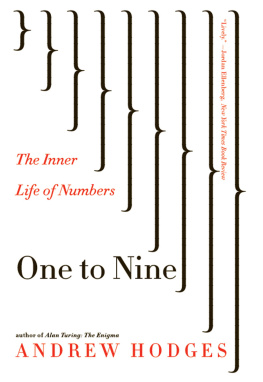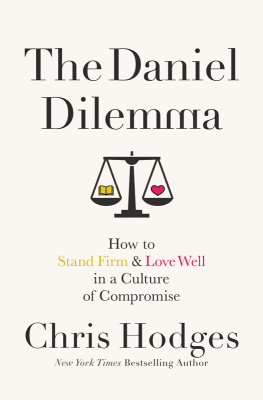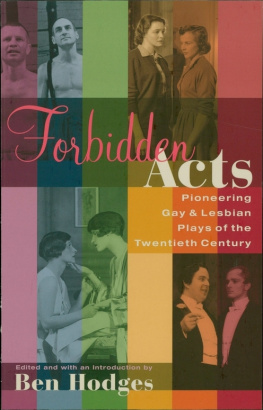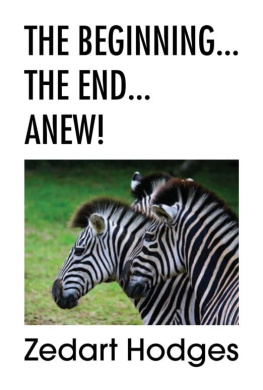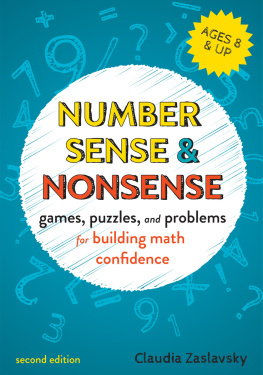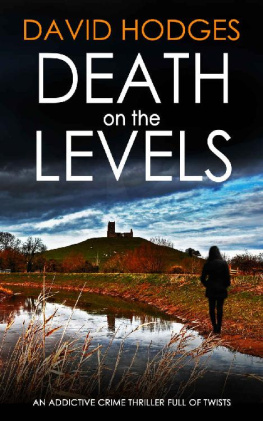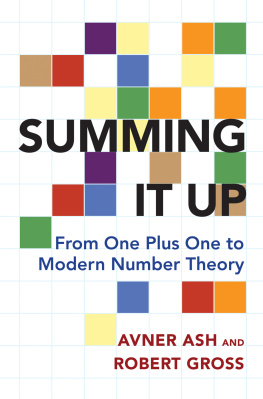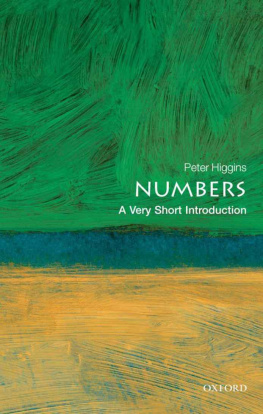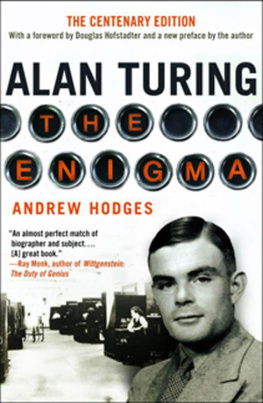W. W. N ORTON & C OMPANY
For information about permission to reproduce selections from this book, write to Permissions, W.W. Norton & Company, Inc.,
500 Fifth Avenue, New York, NY 10110
Hodges, Andrew.
One to nine: the inner life of numbers /
Andrew Hodges.1st American ed.
p. cm.
1. Counting. 2. Numeration. I. Title.
QA113.H635 2008
513.2'11dc22
W.W. Norton & Company, Inc.
500 Fifth Avenue, New York, N.Y. 10110
www.wwnorton.com
W.W. Norton & Company Ltd.
Castle House, 75/76 Wells Street, London W1T 3QT
It is a truth universally acknowledged that a single man in possession of a good fortune must be in want of a wife . So runs a famous first sentence, full of statements about One. It claims a universal truth, but there is an ironic touch in the grandeur of Jane Austens opening, bound as it so obviously is by human pride and prejudice, and specific to the English bourgeoisie of the early nineteenth century. Even so, a modern reader finds it a good story-starter. It is well wired into human brains, tastefully pressing the buttons labelled sex and money in unison.
A chapter about the number One itself cannot count on any such welcome mat. Numbers do not make light conversation, and are gatecrashers at the great party of the human arts. They seem devoid of that sympathetic wit and irony which smooths the passage of letters and life. Indeed, the numbers can hardly join in the human party at all, being abstractions unable to shake hands or flirt. Where did Page One go to?this is already Page Two, and Page One exists only by implication, possessing a One-ness only in ones minds eye.
Even more annoying to the party-goers, is that the numbers adopt unappetising manners whenever they get the upper hand, dictating bossy, tedious and incomprehensible regulations. This is a book about the inner life of these unwelcome guests. It is, more or less, the tale as told by the mathematicians who get to know them. I hesitate to generalise because mathematicians are an un-unionised bunch, with the solidarity of a plate of spaghetti. But the assumption implicit in mathematics is one of universal truths deeper than any Jane Austen would have countenanced as an opening gambit in polite conversation.
Numbers, to mathematicians, are the same for Cleopatra or Moctezuma, for the Neanderthals and the dinosaurs, true in any galaxy, past or future. They tell stories which could be shared with extraterrestrial intelligences. When Dante wanted something for the happy inhabitants of the Paradiso to do with eternal life, he took from Platonic tradition the contemplation of mathematical truth. Not everyone would welcome this connection: the British mathematician G. H. Hardy, who as an atheist wouldnt be seen dead in the One to Nine of Dantes heaven, made a famous declaration of mathematical idealism which had nothing to do with religion.
Prime time
Hardy expressed this other-worldliness by using the concept of a prime number . Any number n can be represented as a multiplication of 1 x n . Put another way, 1 and n are always divisors of n . The prime numbers are those numbers which have only those two divisors, and so enjoy a special relationship with One. The numbers 2, 3, 5, 7 and 11, for instance, are prime. The number 6 is not. The distinction can be seen as a picture. Six objects can be arranged in a rectangle, but seven must lie on a line.
Even the United States is powerless to change the rgime of the primes, and as the stars have swelled from 13 to 50, ingenious means have been necessary to deal with this fundamental problem. In 1940, as those then neatly 6 x 8 states were about to face their transformation into a superpower, Hardy published a short book, A Mathematicians Apology , with a statement of superhuman Number: 317 is a prime, not because we think so, or because our minds are shaped in one way rather than another, but because it is so
What view was Hardy arguing against ? His scorn was reserved for the profilic British polymath biologist Lancelot Hogben, author in 1936 of a major popular book, Mathematics for the Million . Holding his nose, Hardy quoted Hogbens characterisation of mathematics as the grammar of size and order, needed for the planning of the rational society. Hogben was expressing the Marxism of the 1930s, which saw all cultural manifestations as the outcomes of relations of production, and thus mathematics as based in human practice. Hardy was no conservative litist, and in fact had rather radical views. He recognised that mathematics might be useful, but insisted that its utility did not explain why mathematicians did it.
Mathematicians have largely maintained a discreet radio silence, and Hardy was unusual for striking a dissonant note in public. Someone who knew him, C. P. Snow, wrote that Hardy didnt give a damn. Snow himself became famous in the 1960s for trying to combine Jane Austens legacy with insight into twentieth-century science. It is doubtful whether Snow had much success with his unifying vision, and his novels are neglected now. But his expression Two Cultures has stuck as an awkward reminder of the fact that those who run the human world and dominate its discourse are generally unaware of its base in the physical world, and of the mathematics that is the only language for expressing that world. Snow used the Second Law of Thermodynamics as his example of what ought to be well known, but he might as well have used the First Law, or indeed the Zeroth Law, as his examples: it is as true now as it was in the 1960s that none of these can be referred to in polite society.
There is now an extra reason for presenting an unwelcome message about the inescapable properties of numbers, summarised in Al Gores expression of inconvenient truth. Although the question of recent, anthropogenic climate change involves many physical sciencesincluding all those laws of thermodynamicsthe power of mathematics to predict is at the heart of the developing theory. The calculation of climate change certainly falls into Hogbens realm of the relations of human production, but the phrase inconvenient truth could have come from the inconvenient Hardy himself. The Earths atmosphere lacks the simplicity of 317: there are even more factors involved in climate science than in cosmology, where notable corrections have been made, and there are bound to be revisions to current models. And yet those models are essentially mathematical. Environmental campaigners who want to disrupt airports say that the science tells us in terms that they feel put their case above the law, words that recall Hardys it is so. Whether one takes Hogbens viewpoint or Hardys, the question of the potential of mathematics is newly vital.
One and I
In the 1990s, I wrote a weekly column on mathematical topics for the London newspaper, the Observer . The editor, Rebecca Nicolson, contacted me again in 2005 and suggested a short book with the title One to Ten . I saw a point of departure. For this had been done before, in a classic book by Constance Reid, From Zero to Infinity (1956), still in print 50 years later. Her ten chapters were headed by the numbers from Zero to Nine, each used to spark off an elegant exposition of some substantial feature of the theory of numbers. Anything I wrote was bound to resemble her plan.

